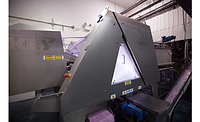Editor's Note
Digital transformations require honest communication, admission of mistakes

Clif Bar simultaneously implemented its visual bakery system in bakeries in Twin Falls, Idaho, (pictured) and Indianapolis.
Photo courtesy of Clif Bar
As I mentioned last month, this issue of Food Engineering is a historic one: The first digital-only issue in the magazine’s long history.
That makes our cover story especially timely. It’s a look at how Clif Bar implemented its visual bakery system in bakeries in Twin Falls, Idaho, and Indianapolis. The projects were going on at the same time; it was a greenfield project in Twin Falls and a renovation project—which always carries unique challenges compared to a greenfield project—in Indianapolis.
Clif Bar was able to overcome those challenges, and the bakeries are now reaping the rewards of the digital transformation. I won’t give it all away here, but the short version is that operating decisions can now be based on real-time data and instantaneous reporting of what’s happening on the production floor.
I’ve talked to a lot of people about these kinds of projects over the last few years, and of course now I’m in the middle of a different kind of one. But there’s one thing in particular that struck me as I conducted interviews for the Clif Bar story. Everyone I talked to mentioned the importance of learning from mistakes and realizing when they were trying to do things the old way.
All too often we expect projects and new ways of doing things to work perfectly, and if there’s something preventing that, it must be somebody’s fault. But more often than not, the cause is simply old habits that are incredibly hard to break. Or something works in design, but not in reality, and it has to be acknowledged and adapted to.
Those are hard things to admit, especially when a major project is drawing a lot of attention from senior leadership or customers. Nobody likes to acknowledge that something is going wrong, and it’s hard to speak up and say “this can’t be right.”
But having honest and direct communication about what is and isn’t working is the difference between success and failure. Identifying challenges and figuring out how to work past them is something we all have to do, no matter how painful it can be.
Looking for a reprint of this article?
From high-res PDFs to custom plaques, order your copy today!






